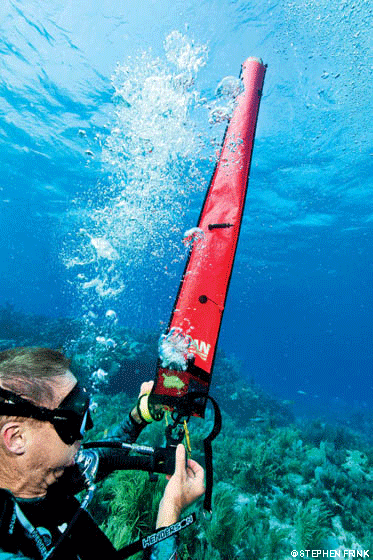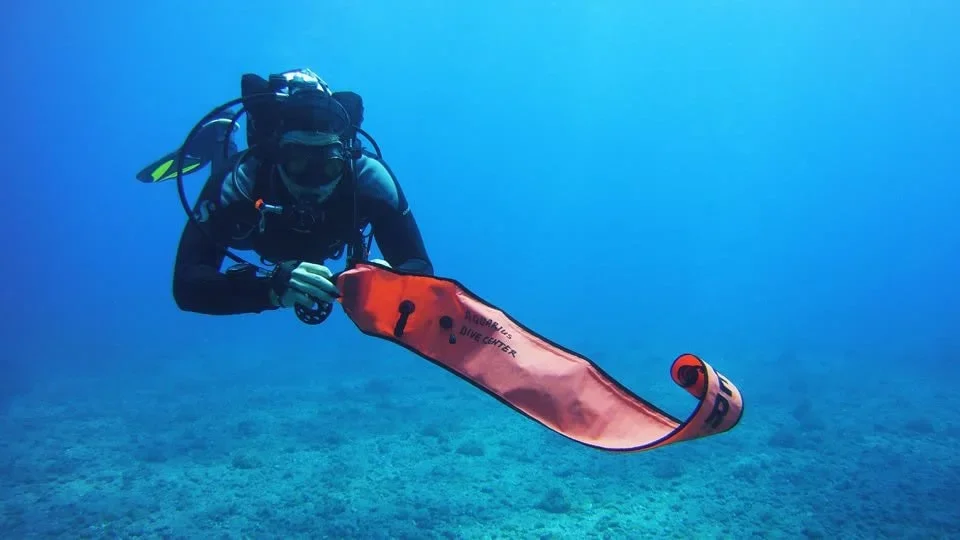DSMB Safety 101: Why You Should Never Clip Your DSMB to Yourself
Surface Marker Buoys (SMBs) and Delayed Surface Marker Buoys (DSMBs) are essential bits of safety kit for UK divers — especially here on the South Coast, where tides, boat traffic and visibility can change fast.
But despite being a standard part of every diver’s equipment, incorrect DSMB use remains one of the most common safety mistakes we see, and the most serious one is simple:
Never attach a DSMB or reel directly to yourself. Ever.
🎈 What Is a DSMB, and Why Do You Need One?
A DSMB (Delayed Surface Marker Buoy) is an inflatable tube that you send to the surface at the end of your dive or during ascent. It marks your position so that your boat crew or shore support can track you safely.
In the UK — where visibility and currents can shift quickly — a DSMB is absolutely essential. It’s your lifeline to the surface and one of the simplest ways to prevent separation or surface accidents.
At Abyss Scuba School, we teach DSMB use on the PADI Open Water, Advanced Open Water, and Surface Marker Buoy Diver specialty courses. Every diver should feel confident deploying one safely and smoothly.
⚠️ Why You Should Never Clip It to Yourself
When you inflate a DSMB, the line connecting you to it becomes an upward force — sometimes a very strong one. If you’re attached to that line, even a small amount of gas expansion can turn dangerous in seconds.
Here’s what can go wrong:
🧨 A rapid, uncontrolled ascent if the buoy rockets to the surface before you can release the reel.
🪢 Entanglement if the line wraps around you or your gear.
⚓ Injury or decompression risk from being dragged upwards unexpectedly.
⚓ Boat impact risk if you surface under a moving vessel.
Even experienced divers have been hurt or lost equipment through this simple error. The rule is clear: the DSMB is yours to manage — not something to be attached to.
🎯 Safe DSMB Use: Step by Step
Prepare your DSMB and reel before the dive.
Make sure the line is untangled and free-running.
Check that your reel or spool is properly wound.
At your safety stop or ascent point:
Hold the reel securely but never lock it off.
Inflate the DSMB using your alternate air source, exhaled breath, or LPI (depending on type).
Keep the line clear.
Let the DSMB rise gently while you maintain control of the reel.
Never wrap the line around your wrist or clip it to your BCD, harness or D-ring.
Maintain neutral buoyancy.
If you feel yourself being pulled upward, let go of the reel immediately.
Always prioritise your own safety over recovering the equipment.
Once the DSMB is at the surface:
Keep gentle tension on the line.
Monitor your depth and complete your ascent safely beneath it.
💡 Top Tips from Our Instructors
Practise DSMB deployment in a pool first — our heated indoor pool at Littlehampton Marina is ideal for building confidence before trying it in open water.
Choose a bright colour DSMB for visibility — orange or yellow are best for UK waters.
Carry a spare spool on deeper dives.
Don’t over-inflate — half-inflated DSMBs still do the job and are easier to control.
Always carry a cutting tool in case of entanglement.
🧭 Learn DSMB Skills the Right Way
Deploying a DSMB safely is one of those core skills that separates confident divers from nervous ones. Whether you’re new to diving or looking to refine your technique, we cover DSMB training as part of:
PADI Advanced Open Water
PADI Surface Marker Buoy Diver Specialty
PADI Rescue Diver
Our team will show you how to choose the right DSMB, practise inflation techniques in the pool, and master safe deployment in open water.
🌊 Final Thought
Your DSMB is a signal, not a tether. It keeps you connected to the surface — not tied to it.
Diving safely is all about smart habits, and mastering your DSMB use is one of the most valuable habits you can build.
👉 Contact us today to join a DSMB skills session or sign up for a PADI course at our heated pool in Littlehampton Marina.
📍 Abyss Scuba School — helping divers stay safe, skilled and confident all year round.






